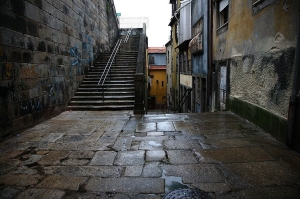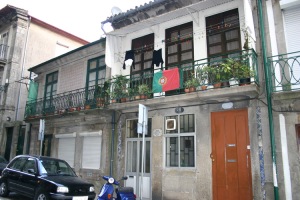In the city of Oporto existed, at least three Jewish quarters (Judiarias): the “Judiaria Velha” (Old Jewry), in Cividade in the current quarter “Bairro da Sé”, in the place where later the Hospital dos Coreiros da Sé was installed; and after this, the “Judiaria de Monchique”.
Over time, the Judiaria de Monchique was becoming small, and Jews began to expand outside the precincts of the Jewish quarter. This gave rise to conflicts and discussions with the Christian population.
Faced with this situation, in 1386, King John I gave orders to the Oporto Municipality to designate a new location, large enough for the habitation of the Jews of the city.
The chosen terrain was an area of olive groves (Olival) in the place then called “das Courelas”. It was rented (aforrado) by the city to the Jews, against the payment of 200 maravedis of 27 soldos each.
The Judiaria embraced the street then called S. Miguel (which include the part known today as Rua de S. Bento da Vitória with which it forms a sort of an elbow) and the streets Taipas, Belo Monte – down to the bottom of the stairs, which until recently were called the Escadinhas da Esnoga (Stairs of the synagogue), and now I think they are also called da Vitoria.
In 1491, shortly before the expulsion of the Jews of Castile, Rabbi Isaac Aboab, the “Gaon of Castile,” negotiated with D. John II the entry of Jewish refugees to Portugal, in order to wait there for the desired repeal the decree of Ferdinand and Isabella. Every Jew, when entering Portugal, had to pay a tax of 8 cruzados.
To the 30 most distinguished Jewish families, including the Gaon’s own, the king assigned residences in the aforementioned S. Miguel street.
Isaac Aboab died in 1493, in Oporto, and was therefore spared witnessing the forced conversion, in 1496, of all Portuguese Jews, including his own family. His son received the new Christian name of Duarte Dias, and his grandson, who also bore the name of the grandfather, Isaac Aboab, was baptized as Henrique Gomes.
From this year on there were no longer public Jews in Portugal. At the site of Judiaria a church and convent were built, and given the name S. Bento da Vitória, symbolizing, it is said, the victory of the church over the synagogue. It was even though until recently, that the church was built on the ruins of the synagogue. 
However, the long stairs which were called (until recently) the “Escadinhas da Esnoga” (Stairs of the Synagogue) lead to the rear of one of the houses of the Rua de S. Miguel. The houses of that street, although they have been benefited several times, with restoration work, kept more or less their original trace. Most of them are owned by the Oporto Misericórdia (a welfare brotherhood).
About 7 years ago, this house was given over by the Misericórdia for the establishment of a day home for elderly people. During the restoration work, the workers noted the existence, in one of the rooms, of a double wall on the eastern side. After that the false wall was removed, they found in the original wall, a built-in closet, a niche, with all the appearance of having been an Ehal (or Aron Hakodesh) where the Sifrei Torah are kept.
The fact that it is on the eastern wall, i.e. in the direction of Jerusalem, to where Jews direct their prayers, and at the exact point at the end of the esnoga stairs, suggests that the synagogue where rabbi Aboab prayed was in this house and not in the site of the present church.*
Years ago, when I visited the site to examine the Ehal, I passed near the entrance to the Monastery of S. Bento da Vitória, in the street of the same name, and I was surprised to see me in the outer wall, a plaque with the following inscription:
“In memory of all Portuguese Jews victims of the infamous decree of 1496 which gave them the option to forced conversion or death.
Earth, do not cover their blood by omission.
Let be restored the blessed memory of all those men and women who have kept alive for five centuries the echo of the word of the living, renewing the prophetic vision of Moses on Mount Horeb:
The bush burned with fire, and the bush was not consumed.
Their burning souls were not destroyed by the flames or by the beings who wanted, through the most terrible torture, forcing them to renounce their sublime faith in the source of life and love.
The just vibrates in his faith”
I had vague information that Captain Barros Basto placed a similar inscription in the wall of the vestibule of the Kadoorie Meḳor Haim synagogue. And that he was forced to hide it under the tile panel, which is still there today. I tried to obtain more information about the origin of the inscription in the wall of the convent. All that I could find out was that it had been placed there in 1996, at the initiative of French Jews, at the occasion of the 500th anniversary of the Decree of Expulsion by King D. Manuel I.
* Since then I have located several more closets in the same style in other places in Portugal. In some cases local tradition indicated that such houses “where in the place of the ancient synagogue. The Tomar synagogue had also such a closet in the eastern wall, which can be seen in ancient pictures. But it was covered during restauration.
